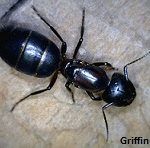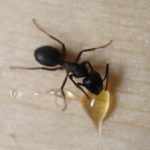Carpenter Ants
Pest Management Fact Sheet #5007
James F. Dill, Pest Management Specialist
Clay A. Kirby (retired), Insect Diagnostician
Charles D. Armstrong, Cranberry Professional & Staff Entomologist
For information about UMaine Extension programs and resources, visit extension.umaine.edu.
Find more of our publications and books at extension.umaine.edu/publications/.
Introduction
Carpenter ants get their name because of their habit of excavating, tunneling and living in wood. In Maine we have primarily the “New York carpenter ant” (Camponotus novaeboracensis) and the “Eastern black carpenter ant” (C. pennsylvanicus). Their habits and sizes are similar, but in Maine, the black carpenter ant species is by far the more common of the two. Carpenter ants are one of the larger ants in Maine, but we also have a very small species of carpenter ant called the “smaller carpenter ant” (C. nearcticus) whose workers are only about 5 mm in length. Nests of nearcticus are reported to be small as well, comprising only a few hundred individuals, but the species is nonetheless still considered a household pest.
Carpenter ants do not eat wood, but rather excavate tunnels and cavities inside of it in order to increase nesting space. In the forest, carpenter ants feed on sap, pollen, nectar, fruits, and both living and dead insects. Water is an important part of their diet. Honeydew, the sweet excretion of aphids–and certain other insects–is also a favorite food.
Description & Biology
Like honey bees, ants are social insects. An ant colony consists of workers and at least one queen. The workers are sterile, wingless females, about 1/4-inch long, the smallest residents of the colony. They gather food and water to feed the colony, and gnaw out wood to make the galleries in which the colony lives.
- Eastern Black Carpenter Ant (wingless queen)
- Eastern Black Carpenter Ant (winged queen)
- Eastern Black Carpenter Ant (worker)
In two to five years, a colony with a good supply of food may form a reproductive or dispersal generation. This generation consists of winged males and females. Males are about 5/8 inches long; winged females are 5/8 to 7/8 inches long. Most males, whose only purpose is to fertilize the female’s eggs, die shortly thereafter. The females shed their wings immediately after mating and become full-fledged queens. In Maine, a 3/4-inch long, wingless ant is probably a queen carpenter ant. They look for wet, rotten wood in which to start new colonies or join an existing one. The queen that starts a new colony lays about 30 eggs and cares for the larvae until they are adult workers. This new generation of workers takes over the various chores in the colony and the queen’s full-time job becomes egg-laying.
The forest is the carpenter ant’s natural habitat. Any wet, rotten wood attracts a new queen. Carpenter ants infest live, dead or fallen trees wherever there is some rot and moisture. In nature, they play an important role in recycling wood, but when they attack buildings they are destructive. The closer a forest with rotten logs is to homes or buildings, the higher the risk is of a carpenter ant infestation.
Abundant water and food supply in proximity to the nest facilitates quick population growth, therefore increasing the need to enlarge the galleries to accommodate the colony. It is the ants’ excavating that damages or weakens wooden structures. Tunneling can take place inside any piece of wood without outwardly visible signs.
Infestations may begin because of a water leak around a chimney, roof valley, gutter, window, door frame, etc. or from water that is leaking in spaces under wooden floors when there is no basement. Sill areas also invite ants, especially if soil touches the wood. Wood covered with back-fill from new construction provides an excellent nesting place. Kitchen and bathrooms are also vulnerable, as a leak in a water pipe, dishwasher hose or water-heating system provides the moisture the ants require. Always check firewood for ants before taking it indoors.
Since carpenter ants are nocturnal, you probably will not see most of them unless they are under stress due to lack of water, food or nesting space, or because they are in a reproductive generation. Worker carpenter ants seen wandering about indoors during the day, particularly in kitchens on countertops and around sinks, are likely ants that have entered the structure (in search of food and water) from an outdoor nest somewhere in the surrounding landscape, especially if there are a lot of trees nearby. This is particularly common in the spring and early summer when outside food sources are often less abundant, or during periods of drought.
Management
The presence of large ants usually is the first sign of infestation. Coarse sawdust is a sure sign, but it is often difficult to find the nest. At night, turning on a light to observe ant activity around a sweet food source that has been left out may reveal an “ant line” to and from the nest. Sometimes the insects’ activity can be heard inside walls. Tapping areas suspected of harboring nests may produce a hollow sound, and some excited ants may appear. Carpenter ants tend to be most active between 10 pm and 2 am.
A household aerosol spray containing pyrethrins can be used as a flushing agent. Direct the spray into cracks, crevices or holes. This will excite the ants so that they will scurry out, revealing the source of the infestation.
Usually, there is no need to tear walls open to eliminate a colony unless repairs are to be made anyway to a faulty or damaged structure. Drilling holes into suspect areas such as walls, sills, joists, underneath sinks, behind appliances or below outside siding can aid in the penetration of insecticide into the nest. Only the nest (if you can find it) needs to be treated. Materials such as boric acid, silica aerogel, bifenthrin, cyfluthrin, deltamethrin or permethrin can be used for treating nest sites. If you cannot locate the nest, but manage to leave an insecticide dust nearby, workers may carry the poison into the nest on their bodies. After treatment, holes can be caulked and touched up with paint, leaving no visible damage.
There is no need to treat walls, floors, counters, cupboards, etc. Any insecticides should be used only as crack, crevice or hole treatments. This reduces human and pet exposure and avoids contamination of other areas. Dusts are most effective and easier to get into wall voids or behind items.
Quick kills are achieved when insecticide is placed in the ants’ nest. Crack and crevice controls usually take longer because it takes time for workers to carry enough insecticide into the nest to kill the colony. Ant baits such as those containing boric acid or liquid borax (e.g. Terro Ant Killer II®) labeled specifically for carpenter ants can be part of a control program.
Place baits out of reach of children and pets!
When Using Pesticides
ALWAYS FOLLOW LABEL DIRECTIONS!
Pest Management Unit
Cooperative Extension Diagnostic and Research Laboratory
17 Godfrey Drive, Orono, ME 04473
1.800.287.0279 (in Maine)
Information in this publication is provided purely for educational purposes. No responsibility is assumed for any problems associated with the use of products or services mentioned. No endorsement of products or companies is intended, nor is criticism of unnamed products or companies implied.
© 2016 | Revised/updated: 2025
Call 800.287.0274 (in Maine), or 207.581.3188, for information on publications and program offerings from University of Maine Cooperative Extension, or visit extension.umaine.edu.
In complying with the letter and spirit of applicable laws and pursuing its own goals of diversity, the University of Maine System does not discriminate on the grounds of race, color, religion, sex, sexual orientation, transgender status, gender, gender identity or expression, ethnicity, national origin, citizenship status, familial status, ancestry, age, disability physical or mental, genetic information, or veterans or military status in employment, education, and all other programs and activities. The University provides reasonable accommodations to qualified individuals with disabilities upon request. The following person has been designated to handle inquiries regarding non-discrimination policies: Director of Equal Opportunity, 101 Boudreau Hall, University of Maine, Orono, ME 04469-5754, 207.581.1226, TTY 711 (Maine Relay System).




